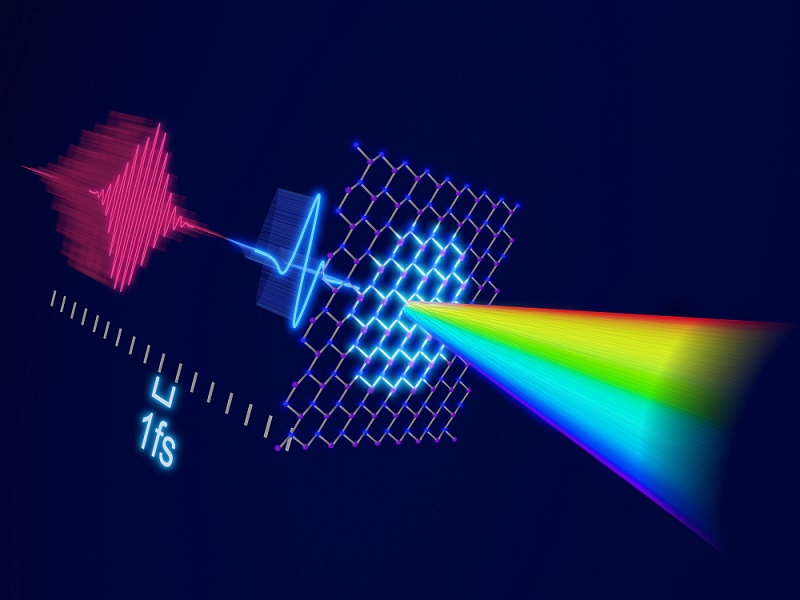Physicists from the Max Planck Institute for the Structure and Dynamics of Matter (MPSD) have illuminated, with laser light, the atomic motions of atoms and electrons contained within a solid. In the theoretical study, the researchers outlined how a laser pulse generates light emission at high frequencies from the material — so-called higher harmonics.
Laser light can radically change the properties of solid materials, making them superconducting or magnetic within millionths of a billionth of a second. The intense light causes fundamental, immediate changes in a solid by “shaking" its atomic lattice structure and moving electrons.
This high-energy light, however, does not stay the same, but changes with each movement of the atomic lattice. As the high harmonics change in intensity, they provide “snapshots” of the atoms’ and electrons’ movements at each moment.

A terahertz pulse (blue) excites atomic vibrations (phonons) in a monolayer of hBN. A subsequent intense IR laser pulse (red) probes the atomic positions by generating high harmonic radiation (rainbow) with temporal information down to 1 fs. In a theoretical advancement, researchers in Germany have developed an approach to probe the fundamental changes in a solid material as the material is irradiated by intense light. Courtesy of Jörg Harms/MPSD.
The team studied a monolayer of hexagonal boron nitride (hBN) just one atom thick, the lattices of which can be excited to vibrate on timescales of tens of femtoseconds. A first pump laser pulse hit the material, making the atoms move in unison. Subsequently, a second infrared laser pulse excited the electrons further. This caused the emission of light at new frequencies — the high harmonics. These carry underlying information about the lattice vibrations (also known as phonons).

The researchers said their findings represent a significant advancement in the understanding of fundamental changes in a solid material while it is being irradiated by an intense laser. The method used in the work is also highly efficient. Previously, researchers needed far more advanced light sources to observe those elementary notions.
The research team showed that once the atoms begin to vibrate, the interaction between the materials and the initial laser pulse changed with the phase of the laser itself. This means that scientists can pinpoint exactly which movement in the lattice was sparked by which phase in the laser’s optical cycle, as if they were setting a stopwatch to that particular moment in time.
In other words, the team’s work has produced a highly advanced spectroscopic technique with extreme temporal resolution, the researchers said.
Using the approach, lattice movements can be charted down to a single femtosecond — but without the need for high-energy x-rays or attosecond pulses, which are far more difficult to employ.
“The main impact of this work is that we are forming a starting point to understand how phonons play a role in nonlinear light-matter interactions,” said lead author Ofer Neufeld from the MPSD Theory Department. “This approach lets us probe femtosecond structural dynamics in solids, including phase transitions, dressed phases of matter, and also coupling between electrons and phonons.”
The research was published in PNAS (www.doi.org/10.1073/pnas.2204219119).